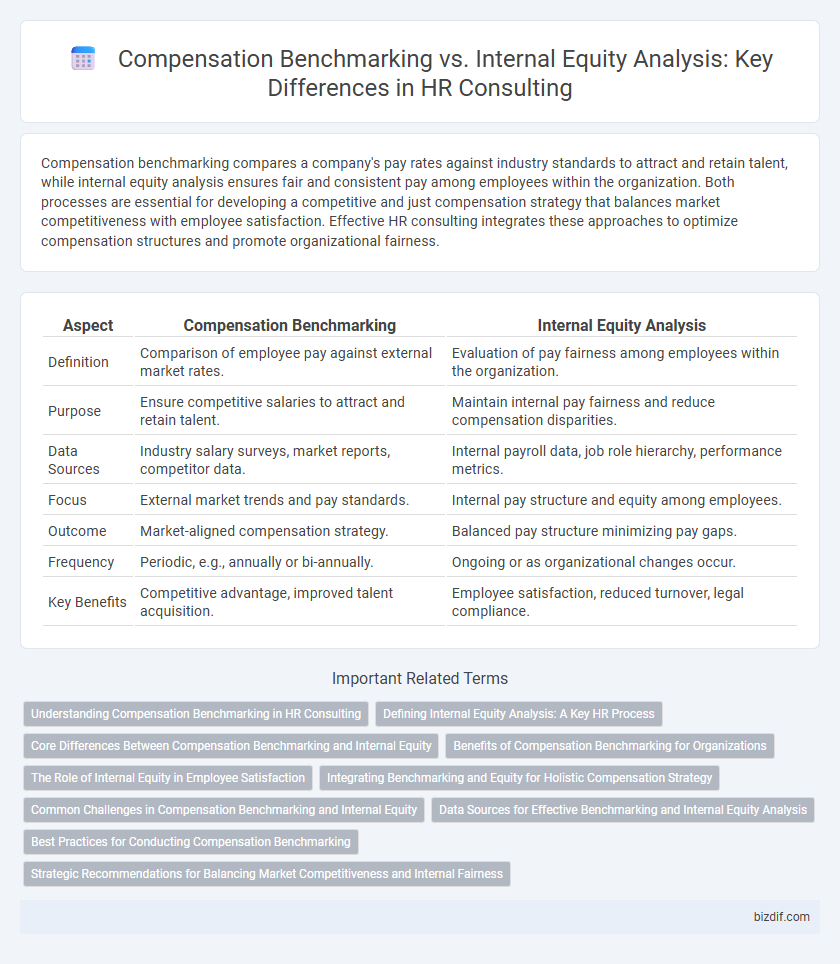Compensation benchmarking compares a company's pay rates against industry standards to attract and retain talent, while internal equity analysis ensures fair and consistent pay among employees within the organization. Both processes are essential for developing a competitive and just compensation strategy that balances market competitiveness with employee satisfaction. Effective HR consulting integrates these approaches to optimize compensation structures and promote organizational fairness.
Table of Comparison
| Aspect | Compensation Benchmarking | Internal Equity Analysis |
|---|---|---|
| Definition | Comparison of employee pay against external market rates. | Evaluation of pay fairness among employees within the organization. |
| Purpose | Ensure competitive salaries to attract and retain talent. | Maintain internal pay fairness and reduce compensation disparities. |
| Data Sources | Industry salary surveys, market reports, competitor data. | Internal payroll data, job role hierarchy, performance metrics. |
| Focus | External market trends and pay standards. | Internal pay structure and equity among employees. |
| Outcome | Market-aligned compensation strategy. | Balanced pay structure minimizing pay gaps. |
| Frequency | Periodic, e.g., annually or bi-annually. | Ongoing or as organizational changes occur. |
| Key Benefits | Competitive advantage, improved talent acquisition. | Employee satisfaction, reduced turnover, legal compliance. |
Understanding Compensation Benchmarking in HR Consulting
Compensation benchmarking in HR consulting involves comparing an organization's pay structures against industry standards and competitors to ensure competitive salary offerings. This process uses market salary data, job roles, and geographic information to align compensation with external trends, attracting and retaining talent effectively. Understanding compensation benchmarking helps identify pay gaps and informs strategic decisions to maintain market positioning and employee satisfaction.
Defining Internal Equity Analysis: A Key HR Process
Internal equity analysis is a critical HR process that evaluates the fairness and consistency of employee compensation within an organization by comparing pay rates across different roles, departments, and levels. This analysis ensures that compensation structures align with organizational values and support employee retention by identifying pay disparities and addressing potential inequities. Unlike compensation benchmarking, which compares salaries externally, internal equity focuses on balancing pay fairness internally to maintain motivation and reduce turnover.
Core Differences Between Compensation Benchmarking and Internal Equity
Compensation benchmarking involves comparing an organization's pay rates with those of competitors to ensure market competitiveness and attract talent. Internal equity analysis evaluates pay fairness within the organization by assessing how employees' compensation relates to their roles, experience, and performance. The core difference lies in benchmarking focusing on external market positioning, while internal equity emphasizes consistency and fairness across job roles internally.
Benefits of Compensation Benchmarking for Organizations
Compensation benchmarking provides organizations with critical market data to set competitive salary structures, ensuring the attraction and retention of top talent in their industry. It enables companies to align their pay scales with external standards, reducing the risk of underpayment or overpayment and promoting fiscal sustainability. By leveraging benchmarking analytics, HR professionals can make informed decisions that enhance workforce motivation and organizational performance.
The Role of Internal Equity in Employee Satisfaction
Internal equity in compensation ensures that employees perceive fairness in pay relative to their peers, significantly boosting job satisfaction and reducing turnover rates. Compensation benchmarking provides external market data but lacks the nuanced understanding of internal roles and contributions that influence morale. Prioritizing internal equity aligns compensation strategies with organizational culture, fostering trust and motivation among employees.
Integrating Benchmarking and Equity for Holistic Compensation Strategy
Integrating compensation benchmarking with internal equity analysis provides a comprehensive framework for designing competitive and fair pay structures. By aligning external market data with internal role value assessments, organizations ensure salary offerings attract top talent while maintaining employee satisfaction and retention. This holistic approach mitigates pay disparities, supports compliance with legal standards, and reinforces transparent compensation policies.
Common Challenges in Compensation Benchmarking and Internal Equity
Common challenges in compensation benchmarking include accessing accurate market data, adjusting for regional salary variations, and selecting appropriate industry peers for comparison. Internal equity analysis faces difficulties in balancing pay fairness across job levels and roles, addressing perceived pay disparities among employees, and integrating diverse employee performance metrics. Both processes require ongoing data validation and alignment with organizational compensation strategies to ensure effectiveness.
Data Sources for Effective Benchmarking and Internal Equity Analysis
Compensation benchmarking relies on external market data sources such as industry salary surveys, government labor statistics, and competitor pay reports to ensure competitive pay structures. Internal equity analysis utilizes internal HR data including job descriptions, employee performance metrics, and current salary records to align compensation fairly within the organization. Combining diverse, high-quality data sources enhances both benchmarking accuracy and internal pay equity assessments for strategic HR decision-making.
Best Practices for Conducting Compensation Benchmarking
Conducting compensation benchmarking involves systematically comparing an organization's pay rates with market standards using reliable salary surveys and industry-specific data to ensure competitive and fair compensation packages. Best practices include selecting relevant benchmark jobs, adjusting for geographic and industry variations, and regularly updating data to reflect market shifts. Integrating benchmarking results with internal equity analysis helps maintain pay fairness among employees while attracting and retaining top talent.
Strategic Recommendations for Balancing Market Competitiveness and Internal Fairness
Effective compensation strategies integrate benchmarking against industry standards with internal equity analysis to ensure competitiveness and fairness within the organization. Leveraging market data on salary trends, benefits, and incentives helps position roles competitively while internal equity metrics assess consistency and fairness across job levels and departments. Strategic recommendations include regularly updating market benchmarks, adjusting pay structures to rectify disparities, and incorporating employee feedback to align compensation practices with organizational goals and culture.
Compensation benchmarking vs internal equity analysis Infographic

 bizdif.com
bizdif.com